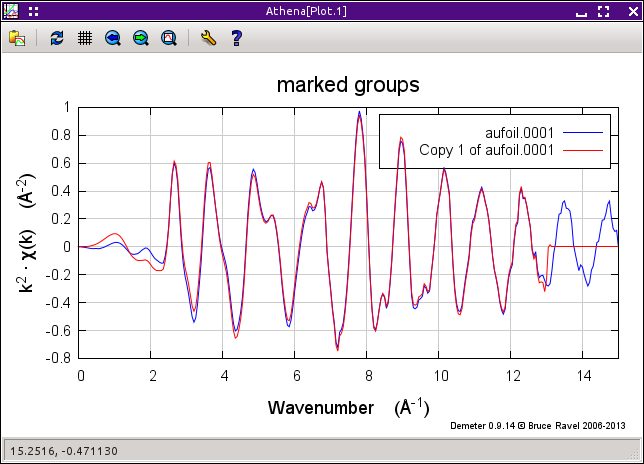4.4. Spline range in background removal¶
Two parameters that can have a big effect on the quality of the background removal are the limits of the spline range. By default, the spline used to approximate the background function is computed between 0.5 Å-1 and the end of the data range. (Those defaults can be set with the ♦Bkg→spl1 and ♦Bkg→spl2 preferences.) In the main menu, there are entry boxes for the values of the spline range in k and in energy. You can edit those interchangeably, when one pair is changed, the other pair is updated. The same is true if you use the pluck buttons to set their values.
There are good reasons to try changing the lower or upper bounds of the spline range. In the case of data with a large, sharp white line, the AUTOBK algorithm might have a hard time following that swiftly changing part of μ(E). The background removal might be improved by starting the spline range at a higher value. A good way to test the effect of spline range is to make a copy (Alt-y) of the data group, change the lower spline boundary to a large value for the copy, and plot both groups as χ(k) or χ(R) using the k button or the R button.
Changing the upper bound of the spline range is often helpful in data where the signal becomes very small at high k such that the level of greatly exceeds the χ(k) data when k-weighted or if the shape of the background function is unstable due to sample inhomogeneity or some other measurement problem.
This shows an example of a change in the upper bound of the spline range.
The obvious effect of changing the spline range is that χ(k) is 0 outside the spline range, as seen on the high-k end of the plot. Changing one end of the spline range can also have an effect on the opposite end of the spectrum. This can be seen on the low-k end of the spectrum in the plot.
When you are working on data for which a good background removal is difficult, changing the spline range is one of the tricks you can pull out of your tool box.
DEMETER is copyright © 2009-2016 Bruce Ravel – This document is copyright © 2016 Bruce Ravel
This document is licensed under The Creative Commons Attribution-ShareAlike License.
If DEMETER and this document are useful to you, please consider supporting The Creative Commons.

